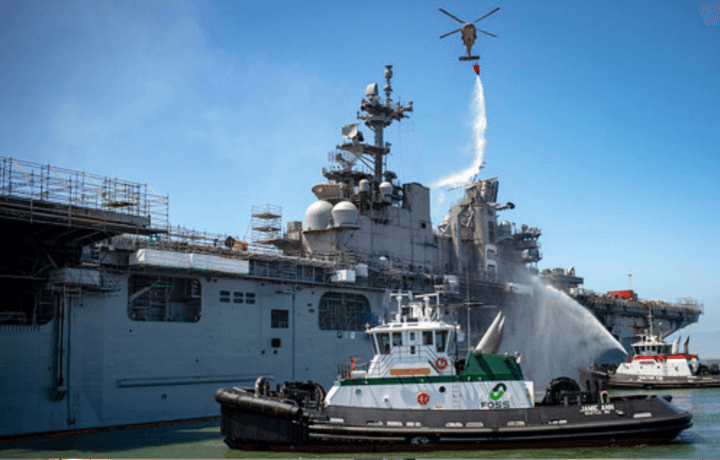As of Tuesday afternoon, “significant progress” was made in putting out the fire on the USS Bonhomme Richard (LHD-6) at Naval Base San Diego. The U.S. Navy’s Rear Adm. Philip Sobeck, commander of Expeditionary Strike Group Three told reporters at a press conference, “We still have an active fire, which we are combating both from within and externally from multiple access points.”
Fire Status
The Navy reaffirmed that the blaze, which began on Sunday morning, was still no threat to the tanks that carry the approximately one million gallons of fuel. A total of 61 people including 38 sailors and 23 civilians had sustained minor injuries, including heat exhaustion and smoke inhalation. However, as of Tuesday afternoon, no personnel were hospitalized as a result of the incident.
The United States Coast Guard was also working with the Navy to prepare for an oil or other hazardous waste spill, while MH-60 Sea Hawk helicopters that form the Helicopter Sea Combat Squadron Three had conducted more than 1,200 water bucket drops to help cool the ship’s flight deck and superstructure.
Wasp-class amphibious assault ship Not a Carrier
While some media outlets have described the warship as a “carrier,” the USS Bonhomme Richard is actually a Wasp-class amphibious assault ship, a design that did evolve from the larger aircraft carriers after the Second World War. Many smaller escort carriers were converted to carry helicopters and originally designated as a class of Landing Helicopter Dock or LHD vessels.
Unlike the U.S. Navy’s larger aircraft carriers, the current generation of LHDs can also support amphibious landings that can be made from the ships’ well deck. As the U.S. Navy employs vertical take-off/landing (VTOL) aircraft, including the AV-8B Harrier II attack aircraft or the F-35B Lighting II stealth strike-fighter, the Wasp-class can carry a compliment of six of either aircraft, while operating much like an aircraft carrier.
USS Bonhomme Richard’s History in the Navy
LHD-6 was named in honor of the famous frigate under the command of America’s first well-known naval commander John Paul Jones. His vessel was named in French “Good Man Richard,” in honor of founding father Benjamin Franklin, who had served as U.S. Ambassador to France.
The warship was launched in March 1997, and it is the flagship for Expeditionary Strike Group Three. The ship had participated in several operations and was deployed as part of Operation Enduring Freedom from December 2001 to June 2002, and supported Operation Iraqi Freedom from January 2003 to July 2006. During the latter operation, the ship was used to offload more than 1,000 Marines and gear from the 3rd Battalion, 1st Marines into Kuwait.
More recently the LHD was used in air-sea rescue operations of a South Korean ferry in April 2014 and took part in training exercises with Australian military personnel.
Progression of the Flames
This past weekend the fire broke out in the cargo hold where supplies were stored as the ship underwent maintenance at Naval Base San Diego. The fire was first reported at 8:30 am and about 160 sailors were on board at the time. The storage may have contained dry wall, heavy duty cardboard boxes and other supplies that may have helped fuel the fire and made it difficult to quickly contain. The debris and other obstacles may have also made it harder for firefighters to get to the fire and properly fight it.
Over the course of two days, the fire had moved throughout the ship and caused damage to its superstructure, including the area where the bridge is located. The water that has been used to fight the fire has further caused the ship to list.
USS Bonhomme Richard Might be Too Expensive to Repair
As of Monday, the Navy had maintained that the ship could still be repaired once the fire was under control, but until the damage can be fully assessed, it may be optimistic thinking. Fires reportedly had ranged to as high as 1,000 degrees, which could seriously compromise the hull.
The Bonhomme Richard is one of eight Wasp-class LHDs while the Navy has two of the newer America-class amphibious assault ships. The average cost of a Wasp–class LHA has been estimated to be around $750 million, while the more recently constructed America-class LHA had exceeded $3.3 billion – and as a result the cost to replace the Bonhomme Richard has been estimated to be in excess of $4 billion.
These ships also form the core of the Navy’s Amphibious Ready Groups, which can embark U.S. Marine Corps expeditionary units. However, the Marines Corps has begun to explore new ways to deploy quickly around the globe that do not require the use of these large warships.
Previous Flames in the Navy
The fire on the Bonhomme Richard is the most serious fire-related incident involving a U.S. warship since July 1967, when a fire broke out on the aircraft carrier USS Forrestal. A total of 134 sailors were killed while another 161 were injured. The repair costs, not including the loss of more than aircraft, exceeded $72 million at the time. However, the Forrestal was able to return to service and was only decommissioned in 1993.




